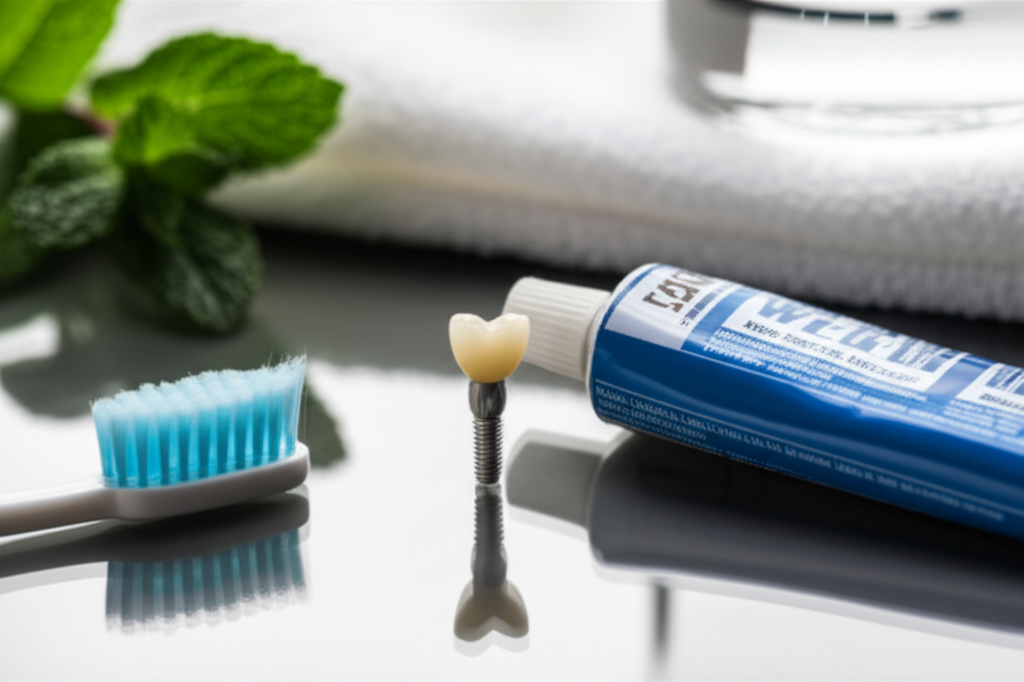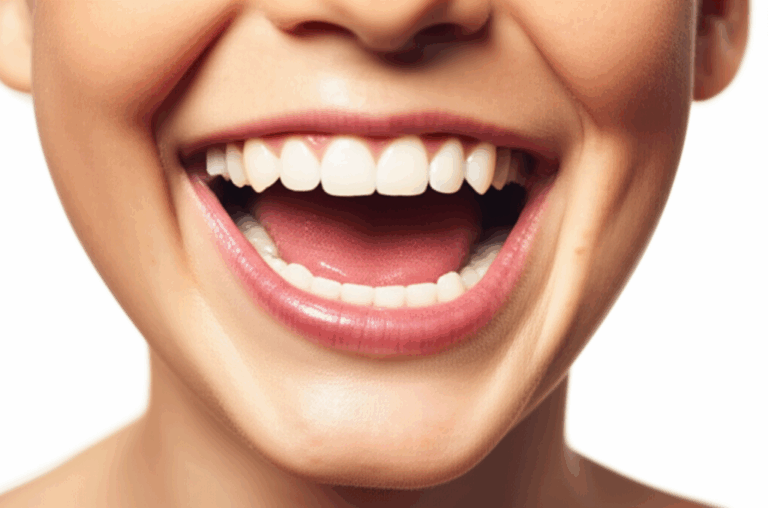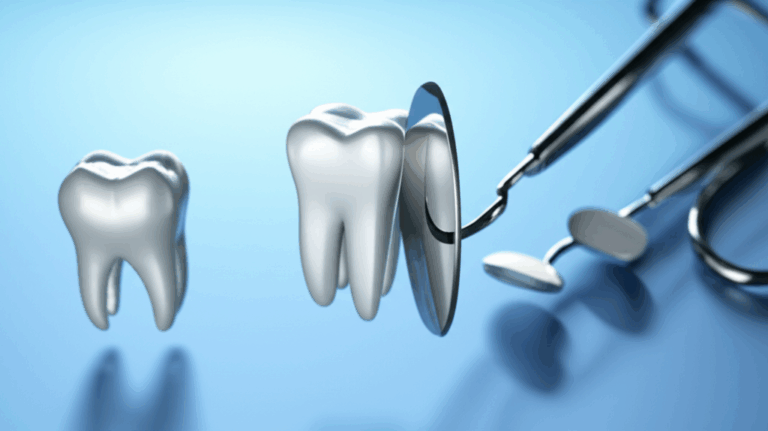
Can You Whiten Dental Implants at Home? The Truth About Implant Discoloration & Care
If you’ve ever wondered if you can make your dental implants whiter at home, you’re not alone. A lot of people notice their implant teeth getting stained or looking darker and hope there’s an easy way to fix it. Here’s the truth: dental implants are not like real teeth! In this article, I’ll clear up some common wrong ideas and show you step by step how to care for your implants so your smile stays bright. Don’t try tricky home fixes that could do harm—read on to learn what really works.
Table of Contents
Can Dental Implants Be Whitened Like Natural Teeth?
Let’s get right to it: No, you can’t whiten dental implants at home with normal tooth whitening stuff. Here’s why: real teeth have tiny holes in the outside layer (enamel), which let bleaching stuff like hydrogen peroxide get in and take out stains. Dental implants and their crowns sit on top and are made from things like porcelain, zirconia, or composite. These don’t soak up bleaching stuff at all.
I once saw a coffee stain on my own crown and thought, “I’ll use whitening strips!” But my dentist told me: what works on real teeth does nothing for an implant crown. You can brush as much as you want, but the color just won’t change.
What Are Dental Implants Made Of?
Dental implants have three main parts: the titanium piece in your jawbone, a small piece that joins the implant to your new tooth, and then the crown (the part you see).
Here’s a quick look at what these crowns are made from:
| Material | Properties | Can It Be Whitened? |
|---|---|---|
| Porcelain (Ceramic) | Very strong, smooth, resists stains | No |
| Zirconia | Super tough, hard to stain, white-looking | No |
| Composite Resin | Not as hard as the others, can stain a bit easier | No |
Porcelain and zirconia show up a lot because they look like real teeth and stay clean. But if they do change color, bleach or whitening paste won’t fix it.
How Does Tooth Whitening Work?
Whitening real teeth is a chemical thing. Here’s what happens:
Implant crowns don’t have real enamel or real stains inside. They are solid stuff with no holes. Even if you rub them with whitening strip or soak in bleaching gel, they just won’t change color.
So, if you’re trying to whiten implants, you’re fighting science—not just a bad stain.
What Causes Dental Implant Discoloration?
Implants themselves don’t pick up stains like real teeth, but the crowns on them can get surface stains. Here are the main causes:
Surface Stains (Outside Only)
- Foods and Drinks: Coffee, tea, red wine, cola, and berries are common.
- Tobacco: Smoking or chewing tobacco stains both real teeth and implants.
- Not Cleaning Well Enough: Plaque and tartar can make crowns look yellow or brown.
Inside Changes
- Metal Showing Through: Sometimes you can see a gray color from the metal part if your gums shrink.
- Crown Gets Worn: After a long time, your crown can start looking dull.
- Leftover Glue: If some dental cement is still under your crown, it might stain over time.
I’ve known friends who tried everything from baking soda to oil pulling—none of these work on the real color of the crown.
Should I Try Over-the-Counter Whitening Products?
Let’s talk about all the stuff you see in the store and ads:
- Whitening toothpaste (with bleach or sharp grains)
- Whitening strips
- Bleaching gels or trays
- Mouth rinses with peroxide
Will any of these whiten implants? No! Some are even bad for you. Toothpaste that’s rough can scratch the smooth top of your crown, making it stain even faster. Whitening strips and gels can’t change the color, but they might bother your gums.
Whitening rinses can make your breath fresh, but they don’t whiten fake teeth. Using these just wastes money, or worse, could mess up your implant.
Are Home Remedies Safe for Implants?
You might have seen people try:
- Baking soda
- Lemon juice
- Activated charcoal
- Apple cider vinegar
- Oil pulling
Lots of these are rough or sour. They sound “natural,” but they scrape or etch your crown. One time I scrubbed my crown with baking soda after too much tea—the shine went away, but stains stayed.
Even gentle ones like oil pulling don’t change how the crown looks. Scrubbing too hard just removes the shiny cover and then stains stick even faster.
What Risks Come With DIY Whitening?
Here are some problems with trying to whiten implants at home:
- Scratching the Surface: Brushing with rough stuff or powders may scratch your crown, so it catches more stains.
- Sore Gums: Strong whiteners or acids can bug your gums, maybe making them pull away.
- No Color Change: After all your effort, the implant still looks the same.
- Hurting Real Teeth or Gums: Abrasive things can hurt nearby real teeth, making them sensitive.
Some people even try scraping off stains with sharp things. Don’t! It’s much safer to go to your dentist.
How Can I Really Make My Dental Implants Look Better?
The good news: you can keep your implants looking nice if you do this:
1. Go to the Dentist for Cleanings
See your dentist or dental hygienist twice a year. They have tools like gentle cleaners (ultrasonic scalers) and soft air polishers to take off stains without hurting your crowns.
Professional cleaning can brighten your crown a lot, especially if coffee, food, or tobacco have left marks.
2. Take Care of Them at Home
- Brush with a soft toothbrush two times each day.
- Pick a gentle toothpaste—not whitening or rough, but safe for dental work.
- Floss or use a small brush every day to clean around the implant. Water flossers are good too!
- Use a mouth rinse without alcohol to help stop plaque.
- Rinse your mouth with water after you eat or drink things that stain.
3. Make Healthy Choices
Try to have less coffee, soda, tea, wine, or tobacco. Your implant and mouth will be much healthier.
When Should I See My Dentist?
Go to your dentist if:
- Stains won’t go away when you brush.
- Your implant is way darker or lighter than the other teeth.
- You see chips or cracks or feel rough spots on the crown.
- Your gums bleed, hurt, or pull away from the implant.
- You just don’t like how your implant looks.
Dentists have special tools to clean stains safely, even in tiny spots.
Don’t wait—catching things early is always cheaper and easier to fix!
FAQs About Whitening Dental Implants
Q: Why did my dental implant get stained?
A: Foods and drinks (coffee, tea, wine, soda) and smoking are big reasons. Also, if you don’t clean well, plaque hardens and looks yellow or brown.
Q: Can I use whitening strips or gels on my implant?
A: No, those only work on real enamel, not implants.
Q: Why doesn’t bleach or peroxide work?
A: Bleach needs tiny holes to go in and break up stains. Porcelain and zirconia have no holes—bleach can’t get in.
Q: Is it safe to scrub my implant crown with baking soda or charcoal?
A: No, these are rough and can scratch the crown, making stains stick easier.
Q: Can dentists change the color of an implant crown?
A: If you aren’t happy with the color, your dentist might be able to polish it or put on a new crown to match your teeth.
Q: How long do implant crowns last before they stain or need replacing?
A: If you take care of them, porcelain or zirconia crowns stay nice for many years. If there are stains, see your dentist—they can clean, polish, or replace it.
Key Takeaways: Keep Your Implants At Their Best
- You can’t whiten dental implants at home like real teeth—no bleach or whitening strips will work.
- Implant crowns are made from strong, smooth materials like porcelain and zirconia; they don’t soak up bleach and don’t stain much.
- Surface stains are possible from foods, drinks, tobacco, and plaque. Professionals can clean these off.
- Don’t use harsh toothpaste or home remedies—they can hurt your crown.
- Best way to keep implants looking good: gentle brushing, flossing or cleaning around them every day, rinse after meals, and regular dentist visits.
- Talk to your dentist if you see odd stains, gum changes, or if you just aren’t happy with the look—they can help fix or replace your crown.
- Protect your smile—implants are a big investment, and if you care for them well, they’ll look good for a long time.








